You probably already know how integral the process of blogging is to the success of your marketing efforts. Which is why it goes without saying it's exceptionally important to learn how to effectively start and manage a blog in a way that supports your business.
Without a blog, you'll find yourself experiencing a number of problems such as poor search engine optimization (SEO), lack of promotional content for social, little clout with your leads and customers, and fewer pages to share your lead-generating calls-to-action (CTAs) on.
So why, oh why, do so many marketers I talk to still have a laundry list of excuses for why they can't maintain a blog?
Maybe because, unless you enjoy writing, business blogging might seem uninteresting, time consuming, and difficult.
Well, the time for excuses is over and this guide is here to help you understand why. We'll cover how to write and manage your business's blog as well as provide helpful templates to simplify your blogging efforts.
Let's get started with an important question.
Today, people and organizations of all walks of life manage blogs to share analyses, instruction, criticisms, product information, industry findings, and more. There are many popular blog formats but, here are six of the most common:
- The "How-To" Post
- The List-Based Post
- The "What Is" Post
- The Pillar Page Post
- The Newsjacking Post
- The Infographic Post
Save time and download six blog templates for free.
So, how do you ensure your blog post catches the eyes of your target audience, buyer personas, and customers?
What makes a good blog post?
Before you write a blog, make sure you know the answers to questions like, "Why would someone keep reading this entire blog post?" and "What makes our audience come back for more?"
To start, a good blog post is interesting and educational. Blogs should answer questions and help readers resolve a challenge they're experiencing — and you have to do so in an interesting way.
It's not enough just to answer someone's questions — you also have to provide actionable steps while being engaging. For instance, your introduction should hook the reader and make them want to continue reading your post. Then, use examples to keep your readers interested in what you have to say.
Remember, a good blog post is interesting to read and provides educational content to audience members.
(Want to learn how to apply blogging and other forms of content marketing to your business? Check out HubSpot Academy's free content marketing training resource page.)
So, how do you actually go about writing one of these engaging and informational pieces?
How to Write a Blog Post
Here are the steps you'll want to follow while writing a blog post.
1. Understand your audience.
Before you start writing your blog post, make sure you have a clear understanding of your target audience.
Ask questions like: What do they want to know about? And, what will resonate with them?
This is where creating your buyer personas comes in handy. Consider what you know about your buyer personas and their interests while you're coming up with a topic for your blog post.
For instance, if your readers are millennials looking to start a business, you probably don't need to provide them with information about getting started in social media — most of them already have that down.
You might, however, want to give them information about how to adjust their social media approach (for example — from what may be a casual, personal approach to a more business-savvy, networking-focused approach). That kind of tweak is what helps you publish content about the topics your audience really wants (and needs).
Don't have buyer personas in place for your business? Here are a few resources to help you get started:
- Create Buyer Personas for Your Business [Free Template]
- Blog Post: How to Create Detailed Buyer Personas for Your Business
- [Free Tool] Make My Persona: Buyer Persona Generator
2. Create your blog domain.
Next, you'll need a place to host this and every other blog post you write. This requires choosing a content management system (CMS) and a website domain hosting service.
Choose a CMS.
A CMS helps you create a website domain where you'll actually publish your blog. CMS platforms can manage domains (where you create your website) and subdomains (where you create a webpage that connects to an existing website).
HubSpot customers host web content via CMS Hub. Another popular option is a self-hosted WordPress website on WP Engine. Whether you create a domain or a subdomain to start your blog, you'll need to choose a web hosting service after you pick a CMS.
Register a domain or subdomain with a website host.
Your blog's domain will look like this: www.yourblog.com. The name between the two periods is up to you, as long as this domain name doesn't yet exist on the internet.
Want to create a subdomain for your blog? If you already own a cooking business at www.yourcompany.com, you might create a blog that looks like this: blog.yourcompany.com. In other words, your blog's subdomain will live in its own section of yourcompany.com.
Some CMSs offer subdomains as a free service, where your blog lives on the CMS, rather than your business's website. For example, it might look like this: yourblog.contentmanagementsystem.com. However, to create a subdomain that belongs to a company website, register the subdomain with a website host.
Most website hosting services charge very little to host an original domain — in fact, website costs can be as inexpensive as $3 per month.
Here are five popular web hosting services to choose from:
3. Customize your blog's theme.
Once you have your domain name set up, customize the appearance of your blog to reflect the theme of the content you plan on creating and your brand.
For example, if you're writing about sustainability and the environment, green might be a color to keep in mind while designing.
If you already manage a website and are writing the first post for that existing website, ensure the article is consistent with the website in appearance and subject matter. Two ways to do this are including your:
- Logo: This can be your business's name and/ or logo — it will remind blog readers of who's publishing the content. (How heavily you want to brand your blog, however, is up to you.)
- "About" Page: You might already have an "About" blurb describing yourself or your business. Your blog's "About" section is an extension of this higher-level statement. Think of it as your blog's mission statement, which serves to support your company's goals.
4. Identify your first blog post's topic.
Before you write anything, pick a topic for your blog post. The topic can be pretty general to start. For example, if you're a company that sells a CRM for small-to-enterprise businesses, your post might be about the importance of using a single software to keep Marketing, Sales, and Service aligned.
Pro tip: You may not want to jump into a "how-to" article for your first blog post.
For instance, if you're a plumber writing your first post, perhaps you'd write about modern faucet setups, or tell a particular success story you had rescuing a faucet before it flooded a customer's house. Here are four other types of blog posts you could start with:
- List ("Listicle"): 5 ways to fix a leaky faucet
- Curated Collection: 10 faucet and sink brands to consider today
- SlideShare Presentation: 5 types of faucets to replace your old one (with pictures)
- News Piece: New study shows X% of people don't replace their faucet frequently enough
If you're having trouble coming up with topic ideas, check out this blog post by my colleague. In the post, she walks through a helpful process for turning one idea into many. Similar to the "leaky faucet" examples above, she suggests you "iterate off old topics to come up with unique and compelling new topics."
This can be done by:
- Changing the topic scope
- Adjusting your time frame
- Choosing a new audience
- Taking a positive/negative approach
- Introducing a new format
5. Come up with a working title.
You might come up with a few different working titles — in other words, iterations of approaching that topic to help you focus your writing.
For example, you may decide to narrow your topic to "Tools for Fixing Leaky Faucets" or "Common Causes of Leaky Faucets." A working title is specific and will guide your post so you can start writing.
Let's take a real post as an example: "How to Choose a Solid Topic for Your Next Blog Post." Appropriate, right? The topic, in this case, was probably "blogging." Then the working title may have been something like, "The Process for Selecting a Blog Post Topic." And the final title ended up being "How to Choose a Solid Topic for Your Next Blog Post."
See that evolution from topic, to working title, to final title? Even though the working title may not end up being the final title (more on that in a moment), it still provides enough information so you can focus your blog post on something more specific than a generic, overwhelming topic.
6. Write an intro (and make it captivating).
We've written more specifically about writing captivating introductions in the post, "How to Write an Introduction," but let's review, shall we?
First, grab the reader's attention. If you lose the reader in the first few paragraphs — or even sentences — of the introduction, they'll stop reading (even before they've given your post a fair shake). You can do this in a number of ways: tell a story or a joke, be empathetic, or grip the reader with an interesting fact or statistic.
Then, describe the purpose of your post and explain how it will address a problem the reader may be experiencing. This will give the reader a reason to continue reading and offer a connection to how it will help them improve their work/lives.
Here's an example of a post we think does a good job of attracting a reader's attention right away:

7. Organize your content in an outline.
Sometimes, blog posts can have an overwhelming amount of information — for the reader and the writer. The trick is to organize the info in a way so readers aren't intimidated by length or amount of content. This organization can take multiple forms — sections, lists, tips — whatever's most appropriate. But it must be organized!
Let's take a look at the post, "How to Use Snapchat: A Detailed Look Into HubSpot’s Snapchat Strategy." There's a lot of content in the piece, so it's broken up into a few sections using descriptive headers. The major sections are separated into sub-sections that go into more detail, making the content easier to read.
To complete this step, all you really need to do is outline your post. This way, before you start writing, you'll know which points you want to cover and the best order to do so in. And to make things even easier, you can download and use our free blog post templates, which are pre-organized for six of the most common blogs. Just fill in the blanks!
8. Write your blog post!
The next step — but not the last — is actually writing the content. We can't forget about that, of course.
Now that you have your outline/template, you're ready to fill in the blanks. Use your outline as a guide and expand on all points as needed. Write about what you already know, and if necessary, conduct additional research to gather more information, examples, and data to back up your points, while providing proper attribution when incorporating external sources.
(Need help finding accurate and compelling data to use in your post? Check out this roundup of sources for inspiration.)
If you're having trouble stringing sentences together, you're not alone. Finding your "flow" can be challenging for a lot of folks. Luckily, there are a ton of tools you can lean on to help you improve your writing. Here are a few to get you started:
- Power Thesaurus: Stuck on a word? Power Thesaurus is a crowdsourced tool that provides users with a number of alternative word choices from a community of writers.
- ZenPen: If you're having trouble staying focused, check out this distraction-free writing tool. ZenPen creates a minimalist "writing zone" designed to help you get words down without having to fuss with formatting right away.
- Cliché Finder: Feeling like your writing might be coming off a little cheesy? Identify instances where you can be more specific using this handy cliché tool.
For a complete list of tools for improving your writing skills, check out this post. And if you're looking for more direction, the following resources are chock-full of valuable writing advice:
- The Marketer's Pocket Guide to Writing Well [Free Ebook]
- How to Write Compelling Copy: 7 Tips for Writing Content That Converts
- How to Write With Clarity: 9 Tips for Simplifying Your Message
- The Kurt Vonnegut Guide to Great Copywriting: 8 Rules That Apply to Anyone
- Your Blog Posts Are Boring: 9 Tips for Making Your Writing More Interesting
- The Beginner's Guide to Starting a Successful Blog in 2019
9. Proofread and edit your post.
You're not quite done yet, but you're close! The editing process is an important part of blogging — don't overlook it.
Ask a grammar-conscious co-worker to copyedit and proofread your post. You may also consider enlisting the help of The Ultimate Editing Checklist or using a free grammar checker like Grammarly.
If you're looking to brush up on your self-editing skills, turn to these helpful posts for some tips and tricks to get you started:
- Confessions of a HubSpot Editor: 11 Editing Tips From the Trenches
- How to Become a More Efficient Editor: 12 Ways to Speed Up the Editorial Process
- 10 Simple Edits That'll Instantly Improve Any Piece of Writing
When you're ready to check your formatting, keep the blog elements in mind ...
Featured Image
Choose a visually appealing and relevant image for your post. As social networks treat content with images more prominently, visuals are more responsible than ever for the success of your blog content.
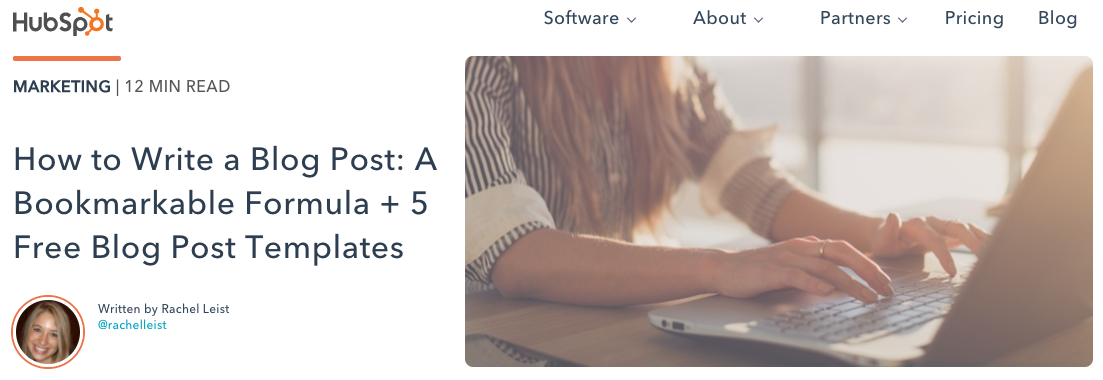
In fact, it's been shown that content with relevant images receives 94% more views than content without relevant images. For help selecting an image for your post, read "How to Select the Perfect Image for Your Next Blog Post" and pay close attention to the section about copyright law.
Visual Appearance
No one likes an unattractive blog post. And it's not just pictures that make a post visually appealing — it's the formatting and organization of the post, too.
In a well-formatted and visually-appealing blog post, you'll notice that header and sub-headers are used to break up large blocks of text — and those headers are styled consistently.
Here's an example of what that looks like:
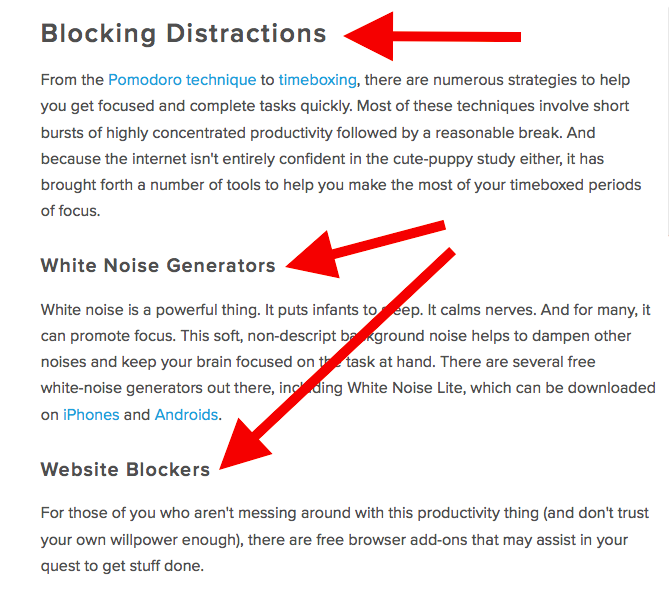
Screenshots should always have a similar, defined border so they don't appear as if they're floating in space — that style should stay consistent from post to post.
Maintaining this consistency makes your content look more professional and easier on the eyes.
Topics and Tags
Tags are specific, public-facing keywords that describe a post. They also allow readers to browse for more content in the same category on your blog. Refrain from adding a laundry list of tags to each post. Instead, put some thought into a blog tagging strategy.
Think of tags as "topics" or "categories," and choose 10-20 tags that represent all the main topics you want to cover on your blog. Then stick to those.
10. Insert a CTA.
At the end of every blog post, insert a CTA that indicates what you want the reader to do next — subscribe to your blog, download an ebook, register for a webinar or event, read a related article, etc.
Your visitors read your blog post, they click on the CTA, and eventually you generate a lead. But the CTA is also a valuable resource for the person reading your content — use your CTAs to offer more content similar to the subject of the post they just finished reading.
In the blog post, "What to Post on Instagram: 18 Photo & Video Ideas to Spark Inspiration," for instance, readers are given actionable ideas for creating valuable Instagram content. At the end of the post is a CTA referring readers to download a comprehensive guide on how to use Instagram for business:
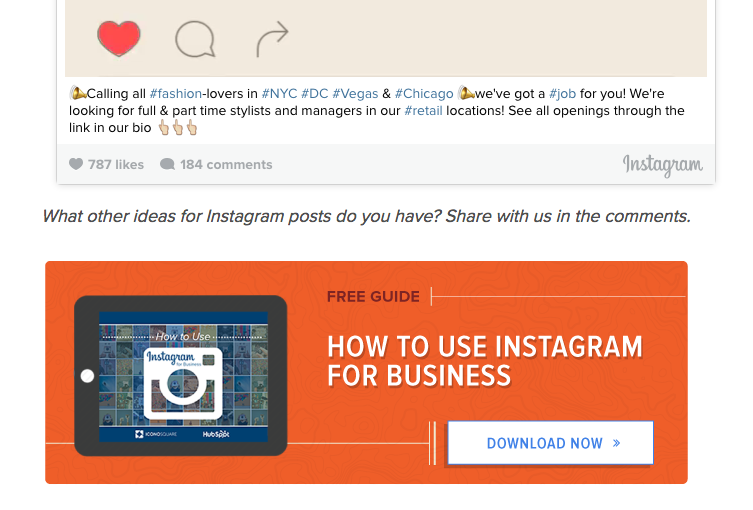
See how that's a win-win for everyone? Readers who want to learn more have the opportunity to do so, and the business receives a lead they can nurture ... who may even become a customer!
11. Optimize for on-page SEO.
After you finish writing, go back and search engine optimize your post.
Don't obsess over how many keywords to include. If there are opportunities to incorporate keywords you're targeting, and it won't impact reader experience, do it. If you can make your URL shorter and more keyword-friendly, go for it. But don't cram keywords or shoot for some arbitrary keyword density — Google's smarter than that!
Here's a little blog SEO reminder about what you should review and optimize:
Meta Description
Meta descriptions are the descriptions below the post's page title on Google's search results pages. They provide searchers with a short summary of the post before clicking into it. They are ideally between 150-160 characters and start with a verb, such as "Learn," "Read," or "Discover."
While meta descriptions no longer factor into Google's keyword ranking algorithm, they give searchers a snapshot of what they'll get from reading the post and help improve your clickthrough rate from search.
Page Title and Headers
Most blogging software uses your post title as your page title, which is the most important on-page SEO element at your disposal. But if you've followed our formula so far, you should already have a working title that will naturally include keywords and/ or phrases your target audience is interested in.
Don't over-complicate your title by trying to fit in keywords where they don't naturally belong. With that said, if there are clear opportunities to add keywords you're targeting to your post title and headers, feel free to take them. Also, try to keep your headlines short — ideally, under 65 characters — so they don't get truncated in the search engine results.
Anchor Text
Anchor text is the word or words that link to another page — either on your website or on another website. Carefully select which keywords you want to link to other pages on your site because search engines take that into consideration when ranking your page for certain keywords.
It's also important to consider which pages you link to. Consider linking pages that you want to rank for a specific keyword. You could end up getting it to rank on Google's first page of results instead of its second page — and that ain't small potatoes.
Mobile Optimization
With mobile devices accounting for nearly two-of-three minutes spent online, having a website with a responsive design is critical. In addition to making sure your website's visitors (including your blog's visitors) have the best experience possible, optimizing for mobile will score your website some SEO points.
To make sure your site is getting the maximum SEO benefit possible, check out this free guide: How to Make a Mobile-Friendly Website: SEO Tips for a Post-"Mobilegeddon" World.
12. Pick a catchy title.
Last but not least, it's time to spruce up that working title of yours. Luckily, we have a simple formula for writing catchy titles that will grab the attention of your reader. Here's what to consider:
- Start with your working title.
- As you start to edit your title, keep in mind that it's important to keep the title accurate and clear.
- Then, work on making your title sexy — whether it's through strong language, alliteration, or another literary tactic.
- If you can, optimize for SEO by sneaking some keywords in there (only if it's natural, though!).
- Finally, see if you can shorten it at all. No one likes a long, overwhelming title — remember, Google prefers 65 characters or fewer before it truncates it on its search engine results pages.
If you've mastered the steps above, learn about some ways to take your blog posts to the next level. Want some real examples of blog posts? See what your first blog post can look like, below, based on the topic you choose and the audience you're targeting.
1. List-Based Blog Post
List-Based Post Example: 10 Fresh Ways to Get Better Results From Your Blog Posts

List-based posts are sometimes called "listicles," a mix of the words "list" and "article." These are articles that deliver information in the form of a list. A listicle uses sub-headers to break down the blog post into individual pieces, helping readers skim and digest your content more easily. According to ClearVoice, listicles are among the most shared types of content on social media across 14 industries.
As you can see in the example from our blog, above, listicles can offer various tips and methods for solving a problem.
2. Thought Leadership Post
Example: What I Wish I Had Known Before Writing My First Book
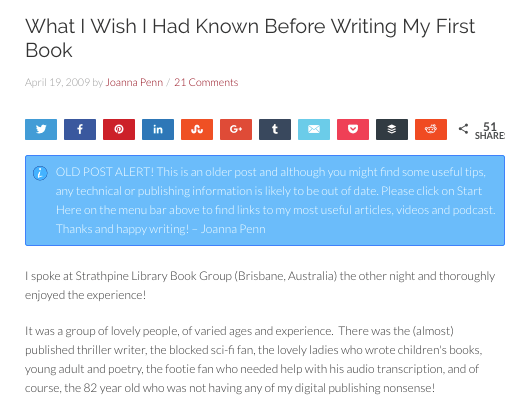
Thought leadership posts allow you to indulge in your expertise on a particular subject matter and share firsthand knowledge with your readers.
These pieces — which can be written in the first person, like the post by Joanna Penn, shown above — help you build trust with your audience so people take your blog seriously as you continue to write for it.
3. Curated Collection Post
Example: 8 Examples of Evolution in Action
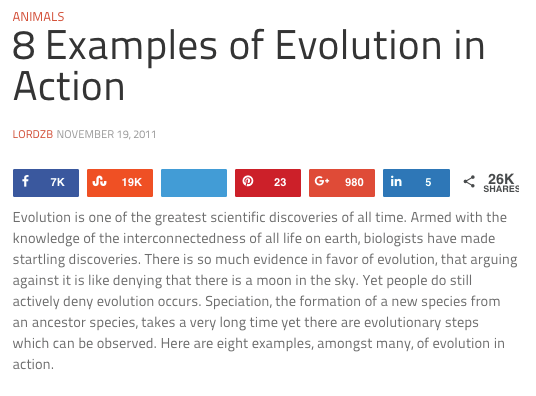
Curated collections are a special type of listicle blog post. Rather than sharing tips or methods for doing something, this type of blog post shares a list of real examples that all have something in common in order to prove a larger point.
In the example post above, Listverse shares eight real examples of evolution in action among eight different animals — starting with the peppered moth.
4. Slideshare Presentation
Example: The HubSpot Culture Code
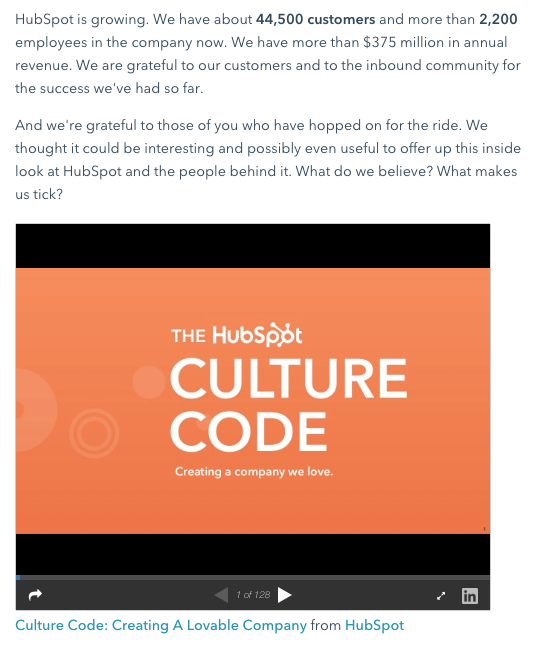
Slideshare is a presentation tool owned by the social network, LinkedIn, that helps publishers package a lot of information into easily shareable slides. Think of it like a PowerPoint, but for the web. With this in mind, Slideshare blog posts help you promote your Slideshare so that it can generate a steady stream of visitors.
Unlike blogs, Slideshare decks don't often rank well on search engines, so they need a platform for getting their message out there to the people who are looking for it. By embedding and summarizing your Slideshare on a blog post, you can share a great deal of information and give it a chance to rank on Google at the same time.
Need some Slideshare ideas? In the example above, we turned our company's "Culture Code" into a Slideshare presentation that anyone can look through and take lessons from, and then promoted it in a blog post.
5. Newsjacking Post
Example: Ivy Goes Mobile With New App for Designers

"Newsjacking" is a nickname for "hijacking" your blog to break important news related to your industry. Therefore, the newsjack post is a type of article whose sole purpose is to garner consumers' attention and, while offering them timeless professional advice, also prove your blog to be a trusted resource for learning about the big things that happen in your industry.
The newsjack example above was published by Houzz, a home decor merchant and interior design resource, about a new mobile app that launched just for interior designers. Houzz didn't launch the app, but the news of its launching is no less important to Houzz's audience.
6. Infographic Post
Example: The Key Benefits of Studying Online [Infographic]

The infographic post serves a similar purpose as the Slideshare post — the fourth example, explained above — in that it conveys information for which plain blog copy might not be the best format.
For example, when you're looking to share a lot of statistical information (without boring or confusing your readers), building this data into a well-designed, even fun-looking infographic can help keep your readers engaged with your content. It also helps readers remember the information long after they leave your website.
7. How-to Post
Example: How to Write a Blog Post: A Step-by-Step Guide
For this example, you need not look any further than the blog post you're reading right now! How-to guides like this one help solve a problem for your readers. They're like a cookbook for your industry, walking your audience through a project step by step to improve their literacy on the subject.
The more posts like this you create, the more equipped your readers will be to work with you and invest in the services you offer.
8. Guest Post
Example: Your Bookmarkable Guide to Social Media Image Sizes in 2020 [Infographic]

Guest posts are a type of blog post that you can use to include other voices on your blog. For example, if you want to get an outside expert's opinion on a topic, a guest post is perfect for that.
Additionally, these posts give your blog variety in topic and viewpoint. If your customer has a problem you can't solve, a guest post is a great way to solve that problem.
If you begin accepting guest posts, set up editorial guidelines to ensure they're up to the same standards as your posts.
Ready to blog?
Blogging can help you build brand awareness, become a thought-leader and expert in your industry, attract qualified leads, and boost conversions. Follow the steps and tips we covered above to begin publishing and enhancing your blog today.
Editor's note: This post was originally published in October 2013 and has been updated for comprehensiveness.
No comments:
Post a Comment